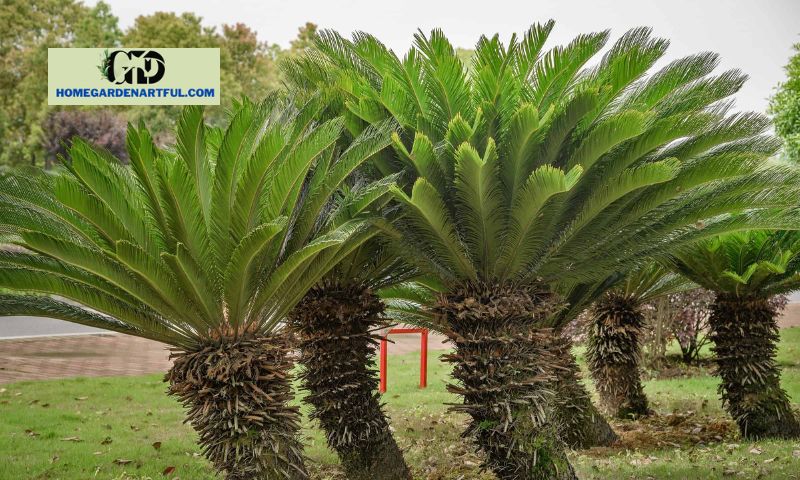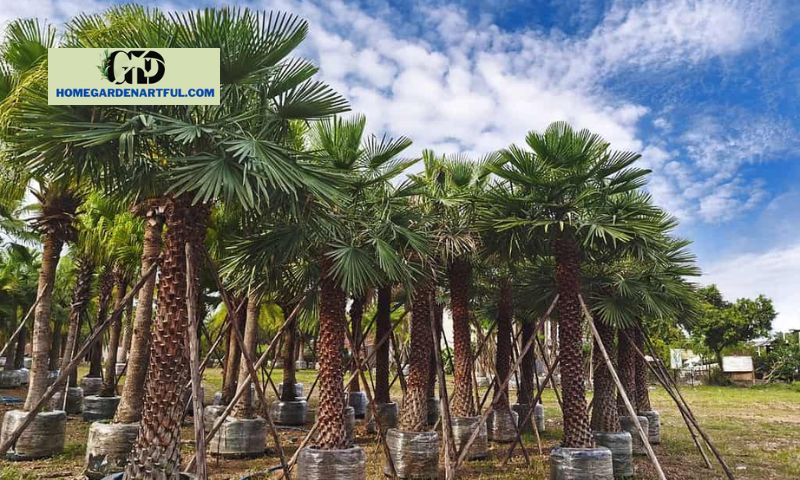You must first understand how palm tree roots function in order to grow a palm tree. How far down should you bury your palm? When planting palm palms, should the roots be cut? Will the roots threaten your home’s foundation? Do palm tree roots need to be treated differently?
Homegardenartful.com is going to give you all the knowledge you require about palm tree roots in this article.
Root Structure of a Palm Tree

The roots of a palm tree are a crucial part of the tree’s structure since they give it support and nourishment. In comparison to other types of trees, palm trees are distinguished from their woody counterparts by their different root systems.
A noteworthy feature of palm tree roots is the lack of secondary development, which is present in the majority of other plants. This suggests that once they reach their maximum length and size, they will stop growing. As a result, palm trees with shallow root systems are particularly vulnerable to being uprooted or knocked over during severe winds or heavy rain.
The composition and purpose of palm tree roots
In order to flourish in tropical climates with plentiful but frequently shallow water, palm tree roots have undergone specific adaptations. The tree can anchor itself firmly in place against severe winds thanks to its massive primary roots, which may reach deep into soils to reach water sources.
By spreading laterally across a large region close below the surface, the adventitious and lateral roots play a significant part in stabilizing the tree. Instead of penetrating deeply, these thin horizontal roots aid in halting soil erosion by clinging to the topsoil layers.
Another intriguing feature of a palm tree’s root system is the abundance of tiny openings known as lenticels. The root system’s internal tissues and the atmosphere can exchange gases thanks to these holes.
Compared to Other Tree Root Types

Palm trees differ architecturally and functionally from other tree kinds due to their distinctive root system. Palm plants often have shallow roots that develop horizontally just below the surface, whereas most trees develop a taproot that extends deep into the earth. This allows palm trees to receive nutrients and water from a wider region. The absence of secondary growth and the inability to thicken over time also make palm tree roots more vulnerable to harm from external elements including temperature, flooding, and severe winds.
Make sure to select a palm species that can withstand cold temperatures if you wish to plant a palm tree there.
The anatomy of palm roots is amazing and distinctive overall. Palm trees have evolved to flourish in tropical environments where water sources are plentiful yet frequently close to the surface thanks to the development of their thick primary roots and wide, shallow lateral roots.
Palm Tree Root Types

The two main types of roots that are present in palm trees are primary roots and lateral or adventitious roots.
On one side, major roots extend from the base of the trunk and delve deeply into the ground. They are thick and lengthy.
On the other hand, lateral or adventitious roots develop from the stem’s nodes that are above ground and extend into the topsoil.
The species and environment of palm trees affect the kind of root system that the tree has. In sandy soil regions with little water availability, shallow roots are typical.
These specific palms have evolved shallow root systems that can quickly absorb moisture from rainfall or irrigation as a result of environmental adaptation. However, because of this, they are also more susceptible to wind destruction during hurricanes or other storms.
On the other hand, palm trees that flourish in areas with plenty of water and nutrients typically have deep root systems. These specific palms have the ability to bury themselves up to 20 feet beneath the ground’s surface, allowing them access to a wider range of water and nutrients.
How the roots of palm trees develop throughout time
Growing palm roots is an interesting process. They don’t have a single central taproot like other trees do. Instead, they have a collection of long, thin roots that spread out from the base of the trunk primarily horizontally.
These roots continue to extend outward and create new root systems as the tree becomes taller. It’s interesting to note that palm plants also contain “feeder roots.” These tiny, hair-like structures, which branch off from the main roots, are in charge of taking moisture and nutrients from the soil.
FAQ
How far down do palm tree roots go?
In contrast to other trees, palm trees often grow their roots horizontally close to the soil’s surface. To offer stability and collect water from a greater region, they dispersed widely. However, the type of palm will greatly influence how deeply the roots finally spread.
Are there any roots on palm trees?
The roots of palm palms are numerous and well ingrained. Although the roots are not deep, they are widely dispersed close to the soil’s surface, allowing the tree to collect water and offer stability.
Do palm trees’ roots cause problems?
The roots of palm trees are typically non-invasive and unlikely to harm buildings or subterranean utilities. Certain palm species, meanwhile, could be dangerous if planted too close to infrastructure or buildings because of their enormous, invasive roots.


